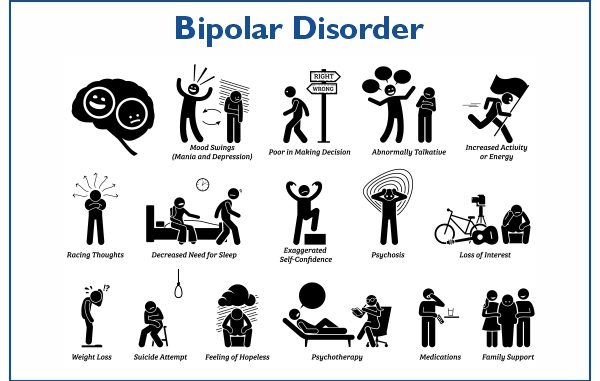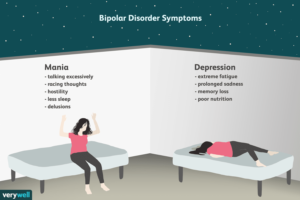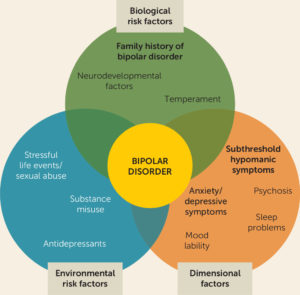
Table of Contents
What is Bipolar Disorder?
- Bipolar disorder (BD), formerly called manic depression, is a mental health illness that results in sharp mood swings, including emotional highs (mania or hypomania), and lows (depression).
- Bipolar disorder (BD) patients go through severe emotional bouts, or mood episodes, that normally last a few days to a few weeks.
- These mood swings might be classified as depressive or manic/hypomanic (an unusually cheerful or irritated mood) (sad mood).
- Most people with BD also have times of neutral mood.
- People with bipolar disorder can live full and productive lives when properly treated.
Causes of Bipolar Disorder
There is no single etiology of bipolar disorder that has been identified by researchers. Currently, they think a number of things could be involved, such as:
1. Genetics
- If a child’s parents or siblings suffer from bipolar illness, their risk of developing the condition is raised.
- Genetics, however, does not always play a role.
- It’s possible for a child with a family history of bipolar illness to never experience the condition.
2. Stress
- A manic or depressive episode can be brought on by a stressful event, such as a loss in the family, illness, a challenging relationship, divorce, or money issues.
3. Brain Function and Structure
- According to certain research, people with bipolar illness may have different brains than those who do not have the condition or any other mental problem.
Signs and Symptoms
- People who have BD go through times of abnormally high emotion, changes in their sleep and activity schedules, and unexpected behaviors, frequently without realizing the potential negative or unpleasant consequences of their actions.
- “Mood episodes” are these clearly defined times. The symptoms last every day for the majority of the day throughout an episode.
- Moreover, episodes might linger for several days or even weeks.
People having maniac/emotional highs episode may experience:
- Feeling extremely “up,” “high,” joyful, or impatient or touchy.
- Feeling “wired” or “jumpy”
- Lessening your need for sleep
- Losing your appetite
- Talking quickly and about a variety of topics.
- Feeling as though their mind is speeding
- Overeating, drinking excessively, spending a lot of money, giving it away, or engaging in reckless sex and believing to accomplish a lot of things at once.
- Feeling as though they have especially high importance, talent, or power

People having depressive episodes may experience:
- Feeling hopeless, empty, depressed, or extremely sad.
- Feeling sluggish or restless
- Having difficulty getting asleep, waking up too early, or sleeping too much
- Feeling more hungry and gain weight
- Talking very slowly, seem to have nothing to say, and frequently forgetting things. Struggle to focus or make decisions.
- Feeling unable to perform even basic tasks
- Possessing lack of interest in nearly all activities, a diminished or absent sex drive, or the inability to enjoy pleasure (anhedonia)
- Feeling useless or hopeless, contemplating suicide or death
Types of Bipolar Disorder
1. Bipolar I disorder
- This kind of BD frequently causes major mood fluctuations and gives the person the impression that everything is going well.
- However, between such instances, regular mood states are frequently experienced.
- In the general population, type 1 BD has a lifetime frequency of about 1%.
- For a patient with bipolar I illness, the manic episode must last for at least 7 days or be severe enough to require hospitalization.
- The symptoms, however, must not be brought on by any other mental illnesses, such as schizophrenia or delusional disorder.
2. Bipolar II disorder
- It is a subtype of BD in which persons alternate between hypomanic and depressed periods, but never go through a “full” manic episode.
- Their mood is generally dominated by depression.
- The mood swings associated with bipolar II disease are extremely dissimilar from those brought on by other mental illnesses or drugs.
- Even though bipolar II disorder symptoms are less severe, they are sometimes accompanied by a wide range of symptoms related to depression, anxiety, or substance misuse.
- Hospitalization is typically not necessary for this disorder.
3. Cyclothymic disorder
- For at least two years, persons with this chronically unstable mood condition experience hypomania and mild depression.
- Cyclothymia patients occasionally have brief periods of normal mood, but these intervals are less than eight weeks.
- Although the illness is on the BD spectrum, it can have a significant negative influence on a person’s quality of life.
- Despite being a milder type of BD, it can develop into a more severe form if unaddressed.
4. Bipolar Disorder, “other specified” and “unspecified”
- When a person does not fit the criteria for bipolar I, II, or cyclothymia but nonetheless experiences times of clinically significant aberrant mood elevation, they are said to have “other specified” or “unspecified” bipolar disorder.
Risk Factors of Bipolar Disorder
1. Biological risk factors
- Family history of BD
- Neuro-developmental factors
- Temperament
2. Dimensional factors
- Sub-threshold hypomanic symptoms
- Anxiety/depressive symptoms
- Mood
- Sleep problems
- Psychosis
3. Environmental factors
- Stressful life events/sexual abuse
- Substance abuse/misuse
- Antidepressants

Preventive Measures
- Although BD cannot be prevented, it is crucial to recognize the early indicators of a coming episode of bipolar depression or mania.
- We can monitor mood and medication use and prevent disease from worsening by early identification of bipolar warning symptoms and routine doctor visits.
- There are several steps that can be taken to enhance the quality of life. They are:
- Maintaining a regular sleeping schedule
- Maintaining your everyday schedule
- Avoiding alcohol and illicit substances
- Getting family and friends to assist you
- Reducing stress at work and home and monitor your mood each day.
- Continuing therapy
Treatment of Bipolar Disorder
- Psychotherapy, such as family-focused treatment and cognitive behavioral therapy.
- Medications like antipsychotic drugs, mood stabilizers, and, to a lesser extent, antidepressants
- Self-management techniques, such as awareness of early indicators of an episode and education.
- Complementary health measures, like aerobic exercise prayer, meditation, and faith can supplement but not replace medical care.
References and For More Information
https://www.mayoclinic.org/diseases-conditions/bipolar-disorder/symptoms-causes/syc-20355955
https://www.nimh.nih.gov/health/topics/bipolar-disorder
https://psychiatry.org/patients-families/bipolar-disorders/what-are-bipolar-disorders
https://www.webmd.com/bipolar-disorder/mental-health-bipolar-disorder
https://www.nhs.uk/mental-health/conditions/bipolar-disorder/overview/
https://www.nami.org/About-Mental-Illness/Mental-Health-Conditions/Bipolar-Disorder
https://ajp.psychiatryonline.org/doi/10.1176/appi.ajp.2017.17090972